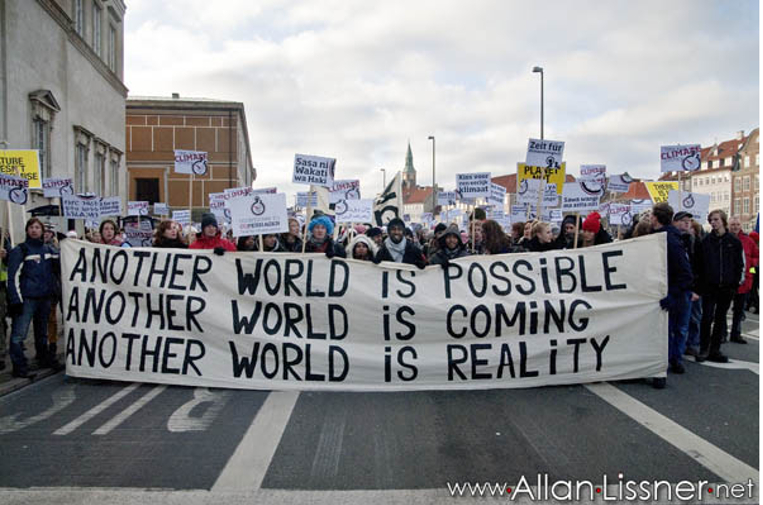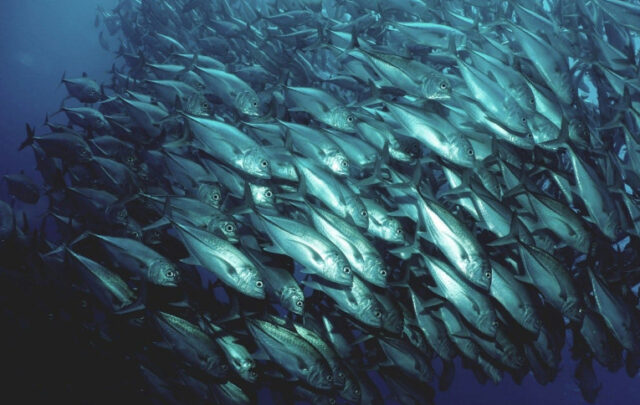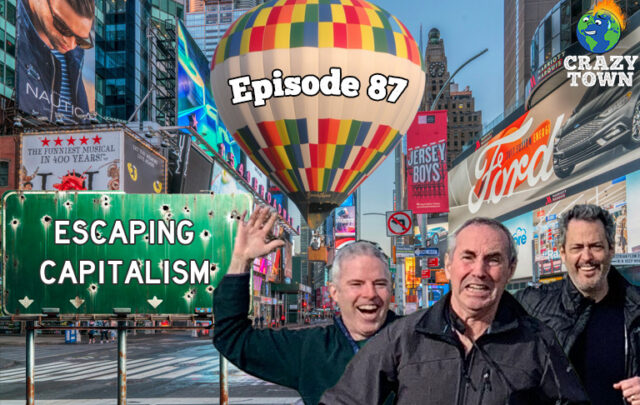Manifesto for a Sociology of the Climate Crisis and of Climate Justice
Ed. note: The following is Chapter 14 of the new book: Cimate Futures: Re-imagining Global Climate Justice, edited by Kum-Kum Bhavnani, John Foran, Priya Kurian, and Debashish Munshi (Berkeley: UC Press/Luminos)
Many intellectuals in the social sciences and humanities do not concede that Earth scientists have anything to say that could impinge on their understanding of the world, because the “world” consists only of humans engaging with humans, with nature no more than a passive backdrop to draw on as we please.– Clive Hamilton (2017)
New realities have always called for new paradigms, and sociology – the study of how societies are structured by inequalities and how they might change – is built on the foundational work of giants like Karl Marx and Max Weber, who grappled with explaining the rise, functioning, and possible future of capitalism as it burst onto the scene in the nineteenth century. The most original and critical works of 20th-century sociology did a decent job of keeping up with the great changes that followed: corporate control of the global economy, the great social revolutions and other attempts to make societies fairer and more just, the rise of social movements demanding rights for women, for people of color, for gendered others, for all humans’ rights generally, and now humans’ responsibilities toward animals, the planet, and the very future we hope to have.
But even while doing so, much of the discipline lost its critical punch, and nowhere has this been so dramatic and fateful as in the inattention of both mainstream and critical sociologists alike to issues of environmental and climate-induced destruction as the 21st century has rolled into being, and as their effects have inexorably become inescapable realities.
The present moment is a dangerous one, calling for our immediate attention, as the academy, like humanity itself, now must scramble to address the existential question of climate change, and with urgency. What has been left to a new generation of younger scholars and activist intellectuals is to trace the contours of the new field we need going forward: a sociology of the climate crisis, and a sociology of climate justice, alongside the movement that bears that name. In other words, the challenge for this generation and its allies is the forging of a completely new understanding within every field of sociology and across the social sciences, the environmental humanities – our close allies in this – and for that matter, all the fields of the natural sciences, engineering, and education, both in the university and among public intellectuals and movement strategists.
This is a tall order. But as radical journalist Chris Hedges (2016) has put it:
It is up to us to resist. We must refuse to be complicit, even in the act of voting, with the fossil fuel industry’s savaging of our ecosystem, endless wars, oppression of the poor, including the one in five children in this country who is hungry, the evisceration of constitutional rights and civil liberties, the cruel and inhumane system of mass incarceration and the state-sponsored execution of unarmed poor people of color in our marginal communities.
Those who respond to the crises of our times must reckon with such questions as:
What might a sociology of climate change look like?
How and why might the global climate justice movement become the biggest, most transformational, and consequential global social movement of the 21st century?
Is it incumbent now to change the way we practice sociology, and if so, what does this mean and how might we do it?
In other words, what are some of the specific contributions that sociology might make to the creation of a strong new field of climate justice studies?
The facts: readily available climate science is extremely clear that the “business as usual” (BAU) global economic model of the current phase of capitalist globalization will take average world surface temperatures past a two degrees Celsius rise, this being best understood as the boundary between “extremely dangerous” and chaotic degrees of climate change (see Anderson 2012, and any analysis of the national pledges that underlie the 2015 UN climate summit’s Paris Agreement).
The situation is far worse, though. Climate science has established the threshold of 1.5 degrees as a far safer upper limit for (hopefully) staving off chaos in the Earth system. And remember too that we are here only talking of average surface temperature warming: what counts is the impact of this on our food systems, fresh water supplies, polar ice, the very air we breathe, ocean life, the increase in devastating storms, droughts, floods, and fires, all of which will vary by region. Elementary social science suggests that our own and subsequent decades will witness dangerous social consequences, including massive migrations of up to several billion people away from flooded coastal cities, chronic wars and many other forms of violence over food, land, and water, and quite possibly the end of democracy in any of the forms we know today toward even more authoritarian, invasively surveillant, militarized states across most of the globe.
A lucid look at these elementary “social facts,” as Durkheim (1982 [1895]) might have called them – the values, cultural norms, and social structures of a given society[2]– suggests that variants on these scenarios become increasingly probable with every tenth of a degree rise above 1.5 degrees. If these analyses are accepted, sociologists need to ask “what kind of carbon budget keeps us under 1.5?” That is, how many greenhouse gasses can humanity put into the atmosphere before we pass that mark? Perhaps this account provides the most succinct overview of our predicament:
If the world pursues the Paris Agreement’s more ambitious limit of 1.5C, the timescales over which global emissions need to peak and start falling rapidly are much shorter….
[T]here are just over four years’ worth of current emissions left before it becomes unlikely that we’ll meet the 1.5C target without overshooting and relying on unproven “negative emissions” technologies to remove large amounts of CO2 out of the air later in the century (Pidcock 2016, emphasis mine; see also Carbon Brief 2017).
Thus, my call to the academic world (and not just that world): it’s now time to wake up and dedicate our collective lives to this civilizational crisis. And that means pretty much dropping BAU scholarship in the BAU university. Instead, educators and students could bring about a massive transformational mobilization of education and civil society at every level, both qualitatively, in what and how we teach and work, and quantitatively, in whom higher education reaches and whom it excludes.
Now, in the age of the Anthropocene, business as usual thinking will be blown away by the insistent winds of climate change, and by all indications, so might capitalism itself, and quite possibly our taken-for-granted “civilizations,” or even humanity itself. And given the existence of abrupt climate change triggers – such as an ice-free Arctic releasing vast stores of methane from the ocean floor – we may be facing these conditions well before 2050, the usual date proposed for driving greenhouse gas emissions down toward zero (Wadhams 2017, McPherson 2017, Wallace-Wells 2017).
A Sociology of the Climate Crisis
What might a sociology of climate change look like?[3] Perhaps it should start with the economic bedrock of the current situation.
The bottom line is what matters here: our economic system and our planetary system are now at war. Or, more accurately, our economy is at war with many forms of life on earth, including human life. What the climate needs in order to avoid collapse is a contraction in humanity’s use of resources; what our economic model demands to avoid collapse is unfettered expansion. Only one of these sets of rules can be changed, and it’s not the laws of nature (Klein 2014: 21).
Neoliberal capitalism’s multiple crises are mostly the effects of its normal operations. In the last 20 years, the rampant privatization of public goods and services has generated obscene inequality and unparalleled concentrations of wealth and power: while just 90 corporations and fossil-fuel exporting countries are responsible for fully two-thirds of all the carbon emissions discharged since the dawn of the industrial revolution, so the richest five individuals in the world now possess as much wealth as the poorest half of humanity – three and a half billion people (Wearden 2014; the original study is by Oxfam 2014)[4]. To this we may add Rob Nixon’s “slow violence” of resource depletion and violence and militarism. With climate change now in the ascendant, we are entering the stage of the coming crisis of capitalism.
The sociology we now need may be defined as the study of everything about this crisis and its possible trajectories. And the first principle of this sociology would be that everything is connected to everything else; curiously, perhaps, this would be one way of stating the first principle of ecology, or the worldview of Buddhism (Batchelor 1997).
Here are some of its characteristics.
Multiple crises
One way to think of the present moment and the foreseeable future is as a triple crisis of economics, democracy, and pervasive violence. We are living in real time through several profound deteriorations in the quality of life on earth:
- A deep and persistent economic crisis is manifest in global economic uncertainty and deep unequal access to well-being in the current period, including vast gender and racial/ethnic/national disparities;
- A crisis of democracy is growing as governments and political parties fail to live up to public expectations in many regions of the world; and
- Violence and militarism saturate the global economy and national cultures as a result of both the economic crisis and the democratic deficit.
The nodes of this triple crisis are bound together by and exacerbate the likelihood of climate chaos. The interdependency of the several crises means that holism is essential to confront climate change, and to advance movements for climate justice. And this implies the joining of intersectional analysis and activist scholarship.
Climate change as a “wicked” problem
As today’s intertwined crises are inextricably linked and bound together, they are exacerbated by the wild card of climate chaos, auguring a perfect storm of crisis (Foran 2016). With climate change, we are faced with a “wicked” problem with no known precedent, something that is
difficult or impossible to solve because of incomplete, contradictory, and changing requirements that are often difficult to recognize…. Moreover, because of complex interdependencies, the effort to solve one aspect of a wicked problem may reveal or create other problems…. A problem whose solution requires a great number of people to change their mindsets and behavior is likely to be a wicked problem (Wikipedia n.d., citing the Australian Public Service Commission 2007).
While many social problems present challenges in the above sense, climate change may be considered a super wicked problem, characterized by four further features: 1) time is running out, 2) those seeking to end the problem (humans, and more precisely, global elites) are also causing it, 3) it is a global collective action problem overseen by, at best, a weak central authority (as anyone who has ever witnessed a U.N. climate summit can attest), all of which lead to the fourth obstacle:
Partly as a result of the above three features, super wicked problems generate a situation in which the public and decision makers, even in the face of overwhelming evidence of the risks of significant or even catastrophic impacts from inaction, make decisions that disregard this information and reflect very short time horizons. It is this very feature that has frustrated so many climate policy advocates (Levin et al. 2012).
Transboundary scholarship: creating a sociology of the future
The interdependency of the several crises besetting us is significant; it means that we need to learn to connect the dots in confronting the climate crisis, and this in turn leads us to the necessary breaking down of all disciplinary boundaries in our paths, and to become well versed in the ecological humanities, social sciences, and physical sciences. If we are trying to focus on the state of the world in the future, say in 2025 or 2050, then sociology will have to open itself to analyzing the future better than it currently does. The dawning of the Anthropocene compels a new relationship to time itself, at once pressing and very short-term for humanity, and long-term as the planet surpasses us into deep time (Angus 2016, Hamilton 2017a, Bonneuil and Fressoz 2016).
A sociology of climate justice and the climate justice movement
To my mind, the pioneers of the sociology of climate justice include the Durban, South Africa-based scholar activist Patrick Bond (2012), and some of the key figures in its origins in the sociology of environmental justice, including Bob Bullard (1990) and David Pellow (2014).
Climate justice perspectives recognize that the brunt of climate change and environmental injustice falls hardest on the most poor and marginal peoples. The injustice of this irreducible reality implicates not only the multiplicity and diversity of responses from nation states, organizations, movements, and individuals, but also includes the recognition of culture, justice, and dignity as central to any meaningful action.
If responding to the challenges of climate justice requires the skills to imagine different futures, then a distinctive feature of the sociology of climate justice should be envisioning scenarios of change and transformation encompassing creative endeavours by artists, writers, and performers who can help re-draw the seeming inevitability of climate chaos into societies where there is hope (Porritt 2013, Raskin 2016, Milkoreit 2016). To paraphrase Naomi Klein (2014): “To change everything, everyone must change.”
Following from this, the question the global climate justice movement confronts is: just how do we somehow keep 80 percent of the remaining reserves of coal, oil, and natural gas in the ground, to hopefully “contain” warming in the 1.5-2 degree range, with the might of the world’s largest corporations and richest governments fused in a determined, indeed suicidal, pact against us?
Both the depth of the current crisis, and the central role played by the climate disruption that exponentially exacerbates it, suggest that our activism around climate change may open a window to moving beyond capitalism in our lifetime. It seems increasingly evident that only a strong and vigorous climate justice movement on a global scale has the capacity to create governments capable of standing up to the economic and political forces of carbon capitalism, and hold governments everywhere to their commitment to social justice.
Principles, practices, dreams, and hope: constructing vibrant political cultures of opposition and creation
It could also be argued that new movements need new theories. This is true in the sociology of revolutions, for example, where the causes, processes, and outcomes of the great 20th-century revolutions differ radically from those of movements for radical social change in the 21st (Foran 2014).
None of the revolutions of the twentieth century was made without powerful political cultures of opposition that proved capable of bringing diverse social groups to the side of movements for deep social change, as happened in the Mexican, Russian, Chinese, Cuban, Nicaraguan, and Iranian revolutions (Foran 2005). These political cultures drew on people’s experiences and emotions and were expressed in complex mixtures of popular, everyday ways of articulating grievances – whether in terms of fairness, justice, dignity, or freedom – and more consciously formulated radical ideologies such as socialism, liberation theology, and anti-colonialism. The most effective revolutionary movements of history have found ways to tap into whatever political cultures emerge in their society, often through the creation of a clear common demand such as “the regime must step down” or “the foreign powers must leave.” The forging of a strong and vibrant political culture of opposition is thus an accomplishment, carried through by the actions of many people, and, like revolutions themselves, such cultures are relatively rare in human history.
In the 21st century, the movements for radical social change (a term more apt for this century’s great social movements than revolution) has itself changed, as activists, reformers, dreamers, and revolutionaries globally have increasingly pursued nonviolent paths to a better world, intending to live and act as they would like that world to be. That is, the ends of justice are no longer held to justify the means of violence, but the means of non-violent resistance reflect and guarantee the ends that they seek. In this, they embody and illustrate the virtues of prefigurative politics and in particular horizontalist ways to realize them.
We might call these positive, alternative visions “political cultures of creation” (Foran 2014; Foran, Gray, and Grosse unpublished ms). Movements become even stronger when they add a positive vision of a better world to a widely felt culture of opposition and resistance, an alternative to strive for that could improve or replace what exists (Pellow 2014). In this sense, some of the differences between old and new movements for radical social change include: the attempt to get away from the hierarchical organizations that made the great revolutions of the 20th century and move in the direction of more horizontal, deeply democratic relations among participants; the expressive power of using popular idioms, visionary narratives and compelling stories using all manner of media; the growing use of civil disobedience and militant nonviolence; the building of coalitions as networks that include diverse outlooks; and the salience of political cultures of creation alongside political cultures of opposition and resistance.
Conclusions
In the long run, the only real systemic “solution” to the crisis is a broad yet at the same time more radical climate justice movement willing to confront the root causes of the crisis, including capitalism. What is also required is the will of nation states, amongst others, to be strong enough to decisively cut emissions in a just way. These movements, or convergence and confluence of many movements, have to get there in the relatively medium term, say, the next quarter century. In the short term of the coming ten to 15 years, the task is to widen and radicalize climate justice movements everywhere, preparing ourselves and a new generation for the longer anti-capitalist project of deep social transformation in the direction of an ecologically sustainable, socially just, and deeply democratic global future.
The sociology that accompanies this will be rooted in climate justice studies and pursued under the banner of scholar-activism and an engaged public sociology, or it will drift into irrelevance as we are engulfed by the failure to understand what is happening to us. The path opens before us to choose the former as we wake up from the latter.
The good news is that if we deal wisely with this problem, this crisis, then we’re going to build a world that works better than the one we have right now, a world that works fairly, is more democratic, less unequal.– Bill McKibben

Graphic by Summer Gray.
References
Anderson, Kevin. 2012. “Climate Change Going Beyond Dangerous – Brutal Numbers and Tenuous Hope.” Pp. 16-40 in Niclas Hällström, editor, What Next? Climate, Development and Equity. Uppsala: Dag Hammarskjöld Foundation, http://www.whatnext.org/resources/Publications/Volume-III/Single-articles/wnv3_andersson_144.pdf
Angus, Ian. 2016. Facing the Anthropocene. New York: Monthly Review.
Australian Public Service Commission. 2007. “Tackling Wicked Problems: A Public Policy Perspective.” October 25. http://www.apsc.gov.au/publications-and-media/archive/publications-archive/tackling-wicked-problems
Batchelor, Stephen. 1997. Buddhism without Beliefs. New York: Riverhead Books.
Bond, Patrick. 2012. Politics of Climate Justice: Paralysis Above, Movement Below. Durban: University of KwaZulu-Natal Press.
Bonneuil, Christophe and Jean-Baptiste Fressoz. 2016. The Shock of the Anthropocene: The Earth, History and Us. Translated by David Fernbach. London: Verso.
Bullard, Robert. 1990. Dumping In Dixie: Race, Class, and Environmental Quality. Boulder: Westview.
Carbon Brief. 2017. “Carbon Countdown: Just Four Years Left of the 1.5C Carbon Budget.” April 5. https://www.carbonbrief.org/analysis-four-years-left-one-point-five-carbon-budget
Durkheim, Emile. 1982. [1895]. The Rules of Sociological Method and Selected Texts on Sociology and Its Method. Edited with an introduction by Stephen Lukes. Translated by W.D. Halls. New York: The Free Press.
Foran, John. 2005. Taking Power: On the Origins of Third World Revolutions. Cambridge: University of Cambridge Press.
Foran, John. 2014. “Beyond Insurgency to Radical Social Change: The New Situation.” Studies in Social Justice 8 (1): 5-25.
Foran, John. 2016. “Reimagining Radical Climate Justice.” Pp. 15-170 in Paul Wapner and Hilal Elver, editors. Re-Imagining Climate Change. New York: Routledge.
Foran, John, Summer Gray, and Corrie Grosse. Unpublished ms. “Not Yet the End of the World: Political Cultures of Opposition and Creation in the Global Youth Climate Justice Movement.”
Hamilton, Clive. 2017. “The Great Climate Silence: We are on the Edge of the Abyss but We Ignore It.” The Guardian. May 4. https://www.theguardian.com/environment/2017/may/05/the-great-climate-silence-we-are-on-the-edge-of-the-abyss-but-we-ignore-it
Hamilton, Clive. 2017a. Defiant Earth: The Fate of Humans in the Anthropocene. Cambridge: Polity.
Hedges, Chris. 2016. “Defying the Politics of Fear” (November 6), http://www.truthdig.com/report/item/defying_the_politics_of_fear_20161106
Klein, Naomi. 2014. This Changes Everything. New York: Simon and Schuster.
Levin Kelly, B. Cashore B, S. Bernstein S and G. Auld. 2012. “Overcoming the tragedy of super wicked problems: constraining our future selves to ameliorate global climate change.” Policy Sciences 45: 123-145, http://www.google.com/url?sa=t&rct=j&q=&esrc=s&source=web&cd=4&ved=0CDwQFjAD&url=http%3A%2F%2Fmunkschool.utoronto.ca%2Fegl%2Ffiles%2F2015%2F01%2FOvercoming-the-tradegy-of-super-wicked-problems.pdf&ei=REyEVaeYE9HZoASfr4OwDA&usg=AFQjCNEILKkiLl29QTp_eeiY0agDEuh2Dg&sig2=8cG3xWQPnnXmYduOFim29Q&bvm=bv.96339352,d.cGU
Morton, Timothy. 2013. Hyperobjects: Philosophy and Ecology after the End of the World. Minneapolis: University of Minnesota Press.
Milkoreit, Manjana, Meredith Martinez, and Joey Eschrich, editors. 2016. Everything Change: An Anthology of Climate Fiction. Tempe: Arizona State University.
Nixon, Rob. 2013. Slow Violence and the Environmentalism of the Poor. Cambridge: Harvard University Press.
Oxfam. 2014. Working for the Few: Political Capture and Economic Inequality. Oxford: Oxfam. https://www.oxfam.org/en/research/working-few
Pellow, David. 2014. Total Liberation: The Power and Promise of Animal Rights and the Radical Earth Movement. Minneapolis: University of Minnesota Press.
Pidcock, Roz. “Analysis: What global emissions in 2016 mean for climate change goals.” November 15, https://www.carbonbrief.org/what-global-co2-emissions-2016-mean-climate-change?utm_source=Weekly+Carbon+Briefing&utm_campaign=2a886c0482-Carbon_Brief_Weekly_18_11_2016&utm_medium=email&utm_term=0_3ff5ea836a-2a886c0482-303452073&ct=t(Carbon_Brief_Weekly_07_10_2016)
Porritt, Jonathon. 2013. The World We Made: Alex McKay’s Story from 2050. New York: Phaedon Press.
Prasad, Vijay. 2014. The Poorer Nations: A Possible History of the Global South. London: Verso.
Raskin, Paul. 2016. Journey to Earthland: The Great Transition to Planetary Civilization. Tellus Institute. http://www.greattransition.org/documents/Journey-to-Earthland.pdf
Rittel, H. and Webber M. “Dilemmas in a general theory of planning.” Policy Sciences 4: 155-169.
United Nations Development Program. 1999. Human Development Report 1999. New York: UNDP.
Urry, John. 2011. Climate Change and Society. Cambridge: Polity.
Wadhams, Peter. 2017. A Farewell to Ice: A Report from the Arctic. Oxford: Oxford University Press.
Wallace-Wells, David. 2017. “The Uninhabitable Earth.” New York. July 9.
Wearden, Graeme. 2014. “Oxfam: 85 richest people as wealthy as poorest half of the world.” The Guardian. January 20. https://www.theguardian.com/business/2014/jan/20/oxfam-85-richest-people-half-of-the-world
Wikipedia. 2015. “Wicked problem.” https://en.wikipedia.org/wiki/Wicked_problem
*****
[1] To appear in the forthcoming Climate Futures: Re-imagining Global Climate Justice, edited by Kum-Kum Bhavnani, John Foran, Priya Kurian, and Debashish Munshi (Berkeley: UC Press/Luminos).
[2] Although climate change is perhaps better considered as a “hyperobject” in the language of Timothy Morton (2013).
[3] Here I must acknowledge a pioneer in this field, the late John Urry, whose 2011 book Climate Change and Society opened the field so thoughtfully and comprehensively.
[4] In 1999, the United Nations Development Program reported “The net worth of the world’s 200 richest people increased from $440 billion to more than $1 trillion in just four years from 1994 to 1998. The assets of the three richest people were more than the combined GNP of the 48 least developed countries:” UNDP 1999, 36-37, quoted in Prasad 2014, 234.






